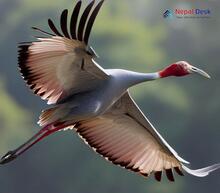The Antigone genus features a captivating collection of birds that belong to the crane family, intriguing both scientists and bird lovers. To truly appreciate these majestic creatures, we can explore their evolutionary history, classification, physical attributes, environmental interactions, and their unique presence in Nepal. Let us look at these aspects in this article:
Tracing the Roots and Categorization
Going back millions of years, the Antigone genus has displayed remarkable adaptability and persistence. The crane family's phylogenetic ties reveal that Antigone has evolved from a shared common ancestor with other crane genera like Balearica and Grus. Genetic studies and fossil records have provided crucial information about their evolutionary journey and ancient beginnings.
It's vital to comprehend the Antigone genus's classification structure within the animal kingdom. This genus includes four different species: Sarus Crane (Antigone antigone), Brolga Crane (Antigone rubicunda), Australian Sarus Crane (Antigone gillae), and White-naped Crane (Antigone vipio). Each species boasts distinct features that differentiate them; however, they all share common traits that place them under one collective grouping.
Physical Traits
These elegant birds are recognized by their elongated legs, extended necks, and slim bodies. Similar to most cranes, Antigone species are quite large birds, growing up to 6 feet tall with wingspans around 8 feet. Their feathers exhibit an enchanting blend of colors – from soft grays and whites to vivid reds – often signifying their respective species or age. These physical characteristics are not only captivating but also crucial for their survival in activities such as foraging or communication.
Environmental Interactions
Antigone cranes flourish in various habitats like wetlands, grasslands, and even agricultural areas. Generally omnivorous, their diet consists of insects, small vertebrates, roots, and seeds. Every species has adapted particularly to its surrounding conditions and local ecosystems. Additionally, they contribute significantly to their habitats by managing pest populations and spreading seeds.
Inhabiting Nepal
Nepal is blessed with an abundance of breathtaking wildlife, the Sarus Crane being one of the nation's rare jewels. These vibrant birds mainly dwell in marshlands and cultivated fields, becoming significant cultural icons in local communities. Preservation initiatives in areas such as Lumbini and Chitwan National Park are essential for ensuring these awe-inspiring creatures' survival and supporting the region's rich biodiversity.
In conclusion, an in-depth look into the Antigone genus' evolution steps, classification structure, physical appearance, ecological adaptations, and unique presence in Nepal unveils striking insights. By deepening our knowledge and admiration for these remarkable birds, we can contribute to existing conservation efforts aimed at safeguarding them for future generations to treasure.




